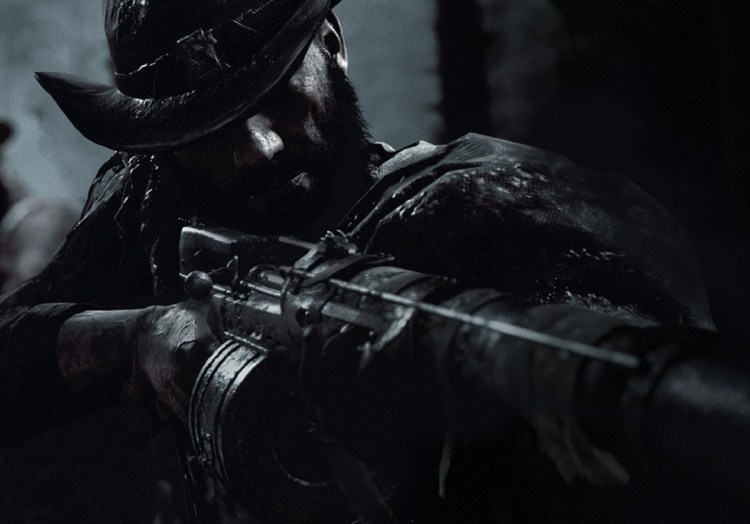If you’re afraid of the dark, Hunt: Showdown is going to scare you. Crytek’s new monster-hunting game is an intense, tension-filled experience where a pair of human bounty hunter players have to track down and kill a monster. Not only that, you have to do it before four other human duos get there first in a landscape that is almost pitch black. Then you have to collect the bounty and escape the map, even as all of the other human players close on you once you slay the monster.
It’s a combination of player-versus-environment and player-versus-player. In fact, it’s a great strategy to watch another team take down the monster and then shoot them to steal the bounty. The action takes place in the dark, where you can light a lantern but then expose yourself to other players. It’s a case where the hunter becomes the hunted.
It’s a “permadeath” game, where you lose everything if you die. You have to evade zombie-like artificial intelligence creatures. If you shoot them, you’ll have to deal with the consequences as the noise and light will draw other bounty hunters. You can communicate via voice chat with your partner, and you have to decide when to go in with guns blazing.
“We have a high-risk, high-reward mechanic,” said Magnus Larbrant, creative director of Hunt: Showdown.
June 5th: The AI Audit in NYC
Join us next week in NYC to engage with top executive leaders, delving into strategies for auditing AI models to ensure fairness, optimal performance, and ethical compliance across diverse organizations. Secure your attendance for this exclusive invite-only event.
I joined a small demo session at the Electronic Entertainment Expo (E3), the big game trade show in Los Angeles last week. Larbrant showed us a demo of the game, and then we asked questions. Here’s an edited transcript of our interview.

Above: Magnus Larbrant, creative director on Hunt: Showdown at Crytek.
Magnus Larbrant: Hunt is a first-person multiplayer monster-hunting game. You’re going to team up with a buddy, go out in an open-world sandbox map, and track down and kill monsters for gold. You’re a bounty hunter. The cool thing with our game is four other teams are doing the same thing. This is a 10-player PvP monster-hunting game. Everybody competes for the same prize.
To make it more unique, we have a challenging AI cast, mainly to raise the tension. Our game is all about the tension. At core we have a high risk, high reward mechanic. Before the level you see a tactical map with some information. You dress up accordingly. You take your favorite stuff, the best stuff you have. If you die that goes straight to hell with you. We’re looking for guys who play survival games, DayZ, that kind of tense PvP action. It’s not really the horror aspect of it, although we do play on that.
The other thing about high tension is we’re creating a world of the unknown here. What’s around the corner? You can’t see. You hear it before you see it. The map should speak to you. That’s why the AI is there. When you and your team move around, you’ll encounter AI and start shooting. All that noise will travel across the map. We have a lot of sound traps. You’ll walk past dogs and they’ll start barking, which also alerts other players. I call it player awareness. You versus what’s happening in the world and how you tactically deal with it.
The game is set at the end of the Victorian age. There’s a world of horror attacking our world. They do so in the most corrupt, dirty, darkest corners of our world. A lot of games in this era are about flair. This isn’t about flair. We’re following a very brutal design language. It’s about dirt and mud and blood. Real fighting, real monsters, real tasks.
To describe the match structure–you’ll recruit hunters. You dress them up according to the tactical map brief. You’ll know in the beginning what you have to hunt. In this demo you’re hunting a monster that’s a human fused with a spider. Very fast, so you need long-range weapons. You start by tracking them. Clues are scattered across the map, normally near human settlements. We have a detective mode that allows you to see dark energy in the world. If you go near, you can establish a connection with the boss and narrow down his location.
When you get to the boss and kill him, you have to banish him in order to get the bounty. That sends off a broadcast across the map. It becomes a hot spot of action. It starts out as very slow and tactical, and then builds up dramatically. That’s the showdown we’re talking about. If you manage to take the bounty, then you need to extract. There are different extraction points. In the detective mode you can follow that bounty as well, so at that point the hunter becomes the hunted. We have different times of day, but the game plays best at night, so that’s what we’ll be showing you here.
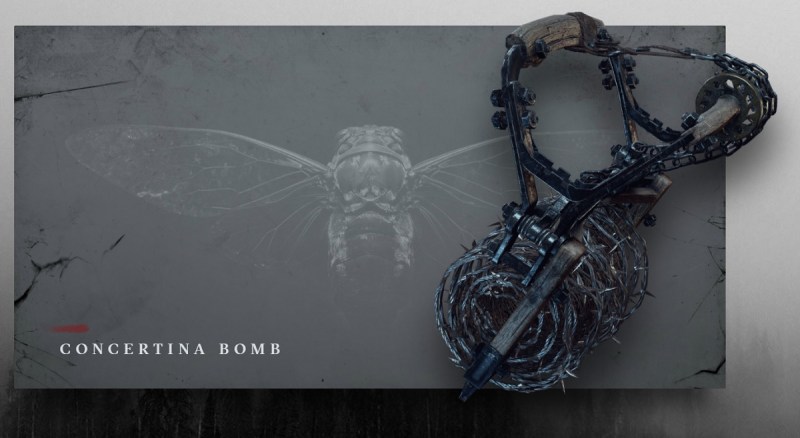
Above: A concertina bomb blocks the way with barbed wire in Hunt: Showdown.
GamesBeat: The spider is not a human player, right? It’s an NPC.
Larbrant: Right. People have been talking about “Evolve meets something,” but this is nothing like Evolve. It’s a team-based monster-hunting game, but it has more to do with the survival gameplay and the tension of permadeath. That’s the core of our game. It’s very social, too. That’s why you play in co-op. We tested playing in single-player, but when you’re playing with a buddy and your buddy goes crazy, you go crazy too. That’s the juice we’re after.
It’s five teams of two players each right now, but we’re experimenting with three teams. We’ll see whatever works the best.
GamesBeat: What would you say about the comparison to Dead by Daylight?
Larbrant: I don’t think they’re much alike. Dead by Daylight is a very boring game. Our AI is much tougher, there are less of them, and they’re more of an obstacle. You’re not necessarily just going to chop your way through everything all the time. It’s about using your gear and figuring out how to get from A to B with all the obstacles in the way.
There’s also a lot of trolling elements. You saw the flare in the demo? With the flare I can see more stuff, but on the other hand, people can see me. When we started gunning, everyone on the map could hear that. That was us fucking up. But the flare works much better as a troll mechanic. You can hide out, see someone coming along, and send up a flare to blind them. A lot of things like that are happening. PvP is the key to this. The AI is there mainly to trigger PvP situations.
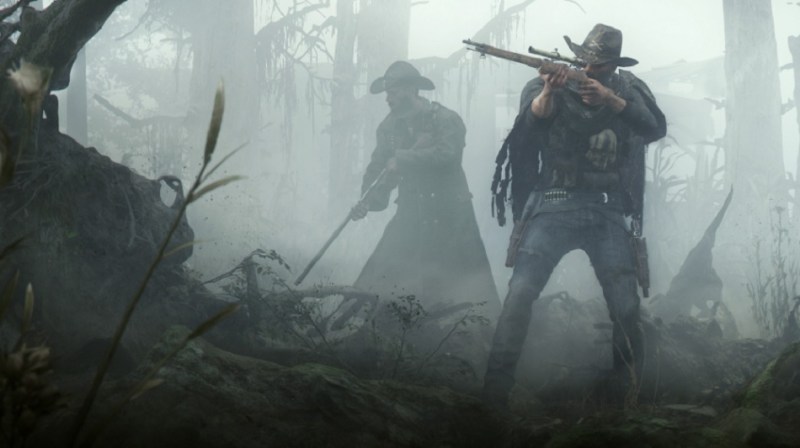
Above: Hunt: Showdown has teams of two human players.
GamesBeat: I saw some kind of flashlight, too, or a lantern. Does that expose you to other human teams as well?
Larbrant: Right. You can turn it on and off. Managing that is part of the game. You keep it off until you’re in trouble and need to get the fuck out, pardon my French. When it’s now or never. Or where you can’t see certain enemies without it. Again, there’s that tension – should I use it or should I not? You don’t want to use it, but you’ll end up in situations where if you don’t use it, you’re going to die.
GamesBeat: How big is that map?
Larbrant: This is one kilometer by one kilometer. We’re going to polish the gameplay until it works as well as it can, before we try to branch out all over the place. We’re focused on this one map for now. It’s quite enough, because there are 15 places where the boss can be, and in every one of those there are multiple locations. Our game has to be very unpredictable. If you can speedrun it, we’re fucked. So we have to keep you guessing where it is. There are villages, churches, graveyards, catacombs, fisherman’s huts, plenty of different areas.
GamesBeat: Do particular types of monsters live in particular parts of the map?
Larbrant: We have a spatial language here. The map has a few different biomes: fields, open water, places like that. Fields can be broken up by trees. On the water there are islands. Different AI can challenge you in different places. We have hell hounds in the fields, which run very fast there. If you run across an open field, cool, you found a shortcut, but if a dog sees you there they’ll come after you. Other monsters live in more tight spaces. Everything we have is some kind of insectoid, a human merged with an insect. Grunts are scattered around settlements. Then we have the meathead, which is focused on area denial. They like choke points here and there, micro-corridors. This is an open world, but every now and then you’ll have to funnel through certain points. We have the hive, which attacks in swarms. There are spaces and enemies that work in combinations.
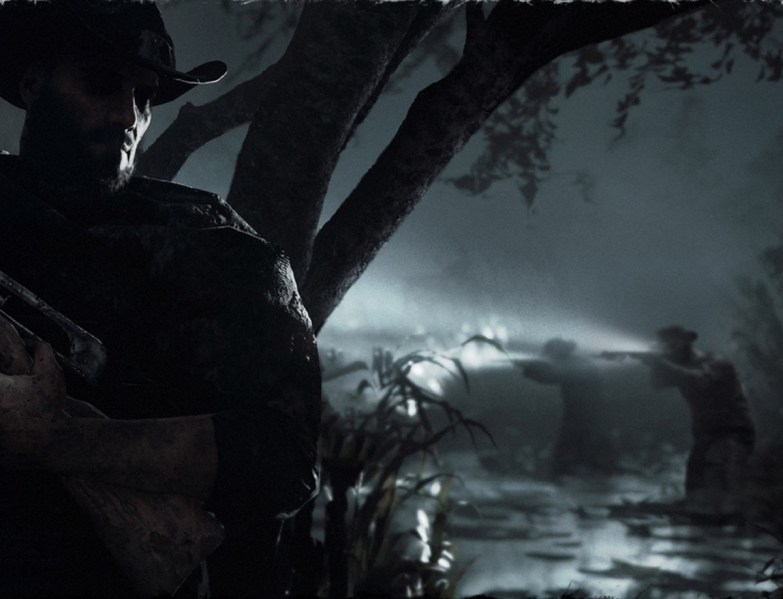
Above: Hunt: Showdown is a permadeath game.
GamesBeat: You guys announced this as part of a larger IP. Can you talk more about the genesis of this project?
Larbrant: I can only speak from my perspective. The guys in Austin worked on the original Hunt game. That was a four-player co-op run-and-gun game. When I was asked to take over—we got the project to Frankfurt from Austin on April 16, 2016 I think. I was asked to do a high-tension hunting game. For me, if you want that tension, it’s all about making the player wonder what’s around the corner. You get that anticipation aspect. Third-person isn’t the best for that, because you can control the camera and see what’s around you. First-person creates a more tense experience. And then of course permadeath makes it into a gamble with your life.
That’s a cool studio, the Darksiders guys. They do cool stuff. But we’re coming from the Crysis direction. We do shooters. There’s many reasons for what happened, but mainly there was a change in direction.
GamesBeat: How large a project would this be, then? It’s a kind of reboot, but are you rebooting into a smaller game than what was planned before?
Larbrant: I think it wasn’t very clear how big that game was going to be. Let me tell you what we’re going to do here. This is not going to be a free-to-play game. But we will invite the audience to help us finish and polish this game as much as possible. I think we can get plenty of gameplay out of this one map. It’s more about producing weapons, gear, gadgets, and tools for you to fight and troll the other guys. We tailored this game for survival gamers who want a bit less walking in the woods collecting stuff and more action. Get them more involved there and start them recording magic moments with other players.
As far as the length of this project, I don’t know right now. But it’s not something we’re going to just do now, finish, and move on to something else. My plan is to do this for a long time.
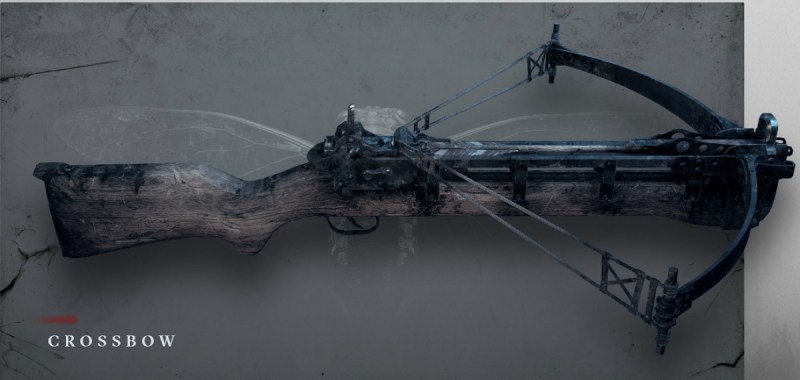
Above: Your crossbow is a silent killer.
GamesBeat: Is the bleeding going to be the only survival element having to do with your health?
Larbrant: Yeah, there’s no environmental element at this point. Currently there’s just the blood. We’ll see. The argument is that this is a dark game. What you can see is limited, even if it’s there. But I want to use the dark sight for a lot more, if we can get enough resources. I want to use it as something like a black light. A guy starts bleeding and then you can track that blood. That’s what I think a lot of these games miss. I get a good hit on someone, but after that I can’t follow up. Again, it’s the hunter becoming the hunted. We’re trying to get that dynamic much more strongly into the game.
GamesBeat: It seems like you have to deal with a complex set of problems. You have to avoid the little zombies, kill the big spider, avoid the other human teams, and escape. There are a lot of steps.
Larbrant: It boils down to tracking the target, killing the target, and running away with the bounty. Now, there are obviously AIs in the way, but they’re just there to telegraph other players’ positions. At that point it’s almost capture flag. I have it, you want it, you kill me and take it. Whoever gets out with the cash gets out with the cash.
GamesBeat: Is there only one bounty per map?
Larbrant: We had one target on this map, but sometimes there will be two: one higher-value and one lower-value. They’re divided up by a zone system. Every time you play those zones change, so you get more replayability out of the game.
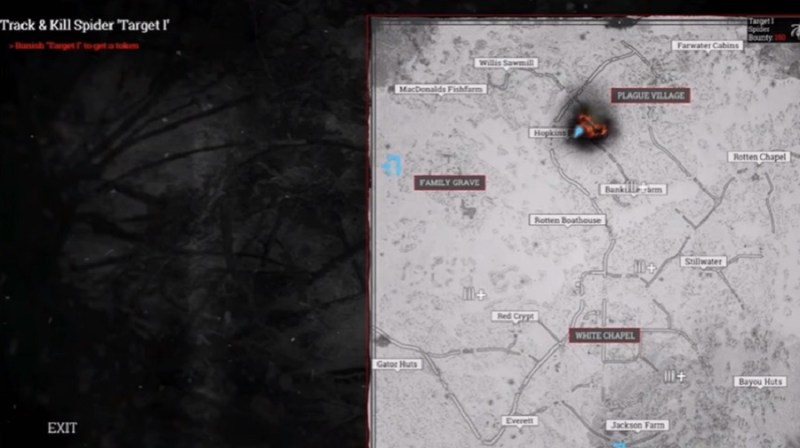
Above: Hunt Showdown’s map tells you where the beast has been killed.
GamesBeat: If you were greedy enough to want both targets, could you take the first one, stick around, and try to get the second one?
Larbrant: Oh, sure, but you have a target on your back the whole time. That’s what happened in the demo. If you know two teams are fighting over there and you’ve killed one team already, it might just leave one more around the corner. Why not go for the extra target? That plays into the co-op aspect. Revival is a big part of co-op. We also have a multiplier for a team escape. We’re thinking about giving you a bonus for running the gauntlet – if you take down both and escape, you get even more. Greed is definitely an aspect of the game.
GamesBeat: What do those symbols mean? Is that just a logo?
Larbrant: The two crosses are two guys going to hunt. The devilish stuff is the hunter that comes to hunt the two. And then at the end you have the letter H, the hunters turned around.
GamesBeat: If you kill other players, can you take anything from them that carries over?
Larbrant: Their stuff, we don’t let you do that. The main reason for that is just to protect the game’s economy. But even if you die permanently, whatever you have unlocked continues in your bloodline. That’s your rank, what you compete with. You basically just hire a new bounty hunter and then you dress him differently. If your hunter survives, he earns hunter points, and he can improve his health bar or add passive traits, like dual-wield quick-firing, stuff like that. If you survive a few times you just get more and more stuff. And of course you care more about losing that character.
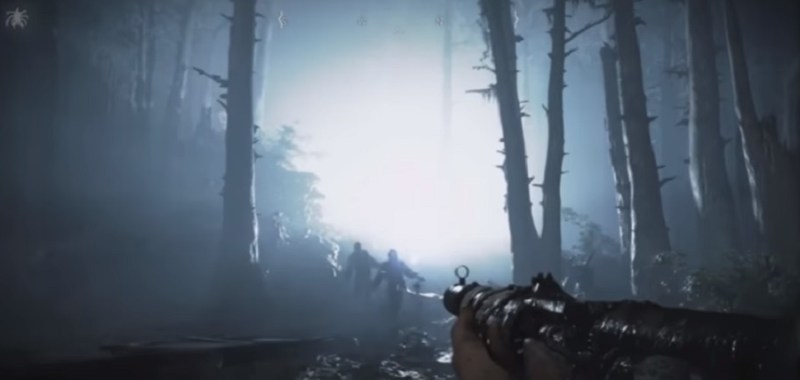
Above: You can throw a flare to illuminate enemies in Hunt: Showdown.
GamesBeat: There wasn’t an immediate convergence of lots of teams on one point, it seemed, even when you had the signal that the bounty was taken. I guess it shows how big the level is.
Larbrant: Yeah, we don’t want it to be as simple as “go here, and if you don’t go there, you’re dead.” It’s not as if you’re dead if you’re outside that part of the fight. It’s just that if you don’t go there, you won’t get any bounty. It’s up to the player. In our game it’s about tracking and activating what you’re after. You’ll get that burning circle on your map, and if you want to go after the cash, that’s where you have to go.
You also don’t need to run in there and start gunning like it’s high noon. You can also sneak around and maybe block an entrance. Then you can wait for another team to come through, ambush them, and take them out. Creating standoffs like that, that’s where the “showdown” comes from.
GamesBeat: How do you deal with people who just want to play as griefers, basically? Say a friend and I drop into the game and we don’t even want to go for the bounty. We just hang out and kill people. Is there anything to deter that from happening? I imagine that if you just take all the other teams out, you can go for the bounty without any obstacles besides the AI.
Larbrant: In some replays, we’ve seen people just head for the middle of the map, wait for someone to take the bounty, and go for them. Now, if you completely ignore the target—yeah, you could find some loot boxes with stuff in them, but you’re not going to get any big wins. You’re not going to be able to afford upgrades. It’s a bit like playing capture the flag, but ignoring the flag. You can still run around and shoot stuff, but it won’t do very much for you. Resources are part of the game as well. You don’t have unlimited ammo.
GamesBeat: How long does each game take?
Larbrant: Between 20 and 40 minutes. Death rate is about 60 percent. We passed on character customization. Instead we have something more like DayZ, where in the beginning, you look kind of like an intern. You’re recruiting interns. After a while tougher guys, cowboys, they start coming to the recruitment centers. Then you have the Indians, the manhunters. There’s a progression, a feeling of advancement at that point.

Above: You can ambush human enemies in Hunt: Showdown.
GamesBeat: Will those guys have better equipment as they progress, too?
Larbrant: Regular equipment is correct to the period, but we also modify and customize some of that. You might have seen one weapon there, a Winchester that has a blade mounted on it. We have belt-fed revolvers, all kinds of things like that. You have normal weapons, customized weapons, and then a few legendary items, like a bomb lance. If you’re fighting a boss you can jam that in and blow it up with a charge of dynamite.
GamesBeat: Would there be any reason for teams to cooperate together, take out a boss, and then they turn on each other?
Larbrant: If players want to team up, that’s cool, but—when you take out a boss, because we’re trying to support two-player co-op, it leaves two tokens. Two bounties. I take one, you take one. If you have four people there, you’d better be really good friends, or they’ll just run off with it.
GamesBeat: So there’s no real reason to ever work together on that level.
Larbrant: No. That’s a primary motivation. This model has potential to do a lot, I think. We could do a battle royale with this pretty easily, too. But before we try to do more variations like that, we want to get this recipe right and support the social aspect.
GamesBeat: You’ve mentioned DayZ. What were the big influences on this idea?
Larbrant: I’m a hardcore survival game player, number one. We took elements from the old game as well. Once we started off, we thought, “How do we get that kind of high-tension PvP combat from a survival game, but in a match-based format like, say, Payday? How do we merge that?” I don’t think we have much in common with Payday, but we have that similarity. Our game has much more dire consequences if you die, though.
